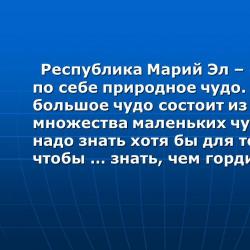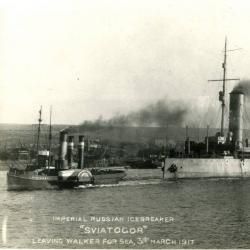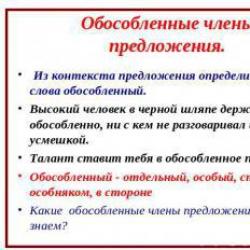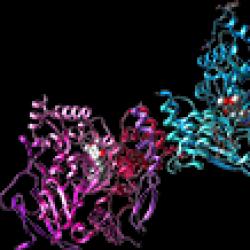Natural resources of the earth's crust presentation. World natural resources. Types of natural resources
Lesson objectives:Lesson objectives:
Build knowledge about species
natural resources of the earth's crust.
Expand features
origin of rocks.
Create a view
about the patterns of placement of useful
fossils
Checking homework:
1. What types of earth's crust do you know?What is their structure?
2. What is the platform and how is it
formed?
3. What movements occur on
moving parts of the earth's crust?
4. Show the largest ones on the map
platforms and mountain systems.
5. Talk about patterns.
placement of the main landforms.
Learning new material:
Using the text of § 10 and figure 26 of the textbook,answer the questions:
1. What groups are the rocks that make up the
the earth's crust, according to the method of formation?
2. How are igneous rocks formed?
3. What igneous rocks do you know?
Name their main properties.
4. What groups are sedimentary rocks divided into?
5. How are metamorphic rocks formed?
breeds?
6. Name the rocks that
formed as a result of metamorphism. The earth's crust has enormous
natural resources,
including land and
mineral resources.
Land resources are
to the category of renewable resources.
Land resources include
areas suitable for
resettlement of people and their accommodation
economic activity.
Mineral resources, or
minerals include
to the category of irreplaceable
resources (ore, fuel). In the distribution of minerals according to
territories of the globe
certain
patterns
Conclusions:
1) in the mountains of folded areas there are usuallydeposits of ore minerals;
2) ore deposits on platforms
confined to the lower tier - folded
foundation, so they focus on the shields
or in those parts of the plates where the thickness of the sedimentary
the cover is small and the foundation comes close
to the surface;
3) most typical for platforms
sedimentary fossils
concentrated in the sedimentary cover. lead role
Among them are fuel resources: coal, oil,
gas.
Homework:
Homework:1) study § 10;
2) answer questions and complete
assignments after the paragraph.
Remember
What minerals do you know?
There are fuel minerals - peat, coal, oil (sedimentary origin).
Ore minerals – ores of non-ferrous and ferrous metals (magmatic and metamorphic origin).
Non-metallic minerals – mining chemical raw materials, building materials, mineral waters, medicinal mud.
This I know
1. What are land resources? Mineral resources?
Land resources are a territory suitable for settling people and locating objects of their economic activity.
Mineral resources are natural substances of the earth's crust suitable for obtaining energy, raw materials and materials.
2. What is the importance of mineral resources in human life?
Mineral resources are the basis of a modern economy. Fuel, chemical raw materials, and metals are obtained from them. The well-being of the country most often depends on the quantity and quality of mineral resources.
3. What determines the placement of mineral resources?
The placement of minerals is determined by their origin.
4. What patterns can be established in the distribution of minerals?
Deposits of ferrous and non-ferrous metal ores, gold, and diamonds are confined to the outcrops of the crystalline basement of ancient platforms. Oil, coal, and natural gas deposits are confined to thick sedimentary covers of platforms, foothill troughs, and shelf zones. Non-ferrous metal ores are also found in folded areas.
5. Where are the main oil and gas deposits concentrated?
The main oil and gas bearing areas are concentrated in shelf zones - the North Sea, the Caspian Sea, the Gulf of Mexico, the Caribbean Sea; sedimentary covers of platforms – Western Siberia; foothill troughs - the Andes and the Ural Mountains.
7. Choose the correct answer. Minerals of sedimentary origin are mainly confined to: a) platform shields; b) to platform slabs; c) to folded areas of ancient age.
B) to the platform slabs
I can do this
8. Using the “Formation of Rocks” diagram (see Fig. 24), explain what transformations occur in rocks as a result of the cycle of substances.
As a result of the cycle of substances, the transformation of some minerals into others occurs. Igneous rocks can be considered primary. They were formed from magma that poured onto the surface. Under the influence of various factors, igneous rocks are destroyed. Debris particles are transported and deposited elsewhere. This is how sedimentary rocks are formed. In folded areas, rocks are crushed into folds. At the same time, some of them dive to depth. Under the influence of high temperatures and pressure, they melt and turn into metamorphic rocks. After the destruction of metamorphic rocks, sedimentary rocks are formed again.
This is interesting to me
9. It is believed that in the Stone Age, almost the only mineral was flint, from which arrowheads, axes, spears, and axes were made. How do you think people's ideas about mineral diversity have changed over time?
People's ideas about the diversity of minerals have changed very quickly since the Stone Age. After flint, people very quickly found copper. The Copper Age has arrived. However, copper products for use were fragile and soft. A little more time passed, and people became acquainted with a new metal - tin. Tin is a very brittle metal. We can assume that what happened was that pieces of copper and pieces of tin fell into the fire or fire, where they melted and mixed. The result was an alloy that combines the best qualities of both tin and copper. This is how bronze was found. The Bronze Age period is the time from the end of the fourth to the beginning of the first millennium BC.
As we all know, iron in its pure form is not found on Earth - it must be extracted from ore. To do this, the ore must be heated to a very high temperature, and only then can iron be smelted from it.
That centuries were named after minerals speaks to their enormous importance. The use of ever new mineral resources opens up new opportunities for humans and can radically change the entire economy.
A lot of time has passed since then and now people use a huge amount of mineral resources for various purposes. Exploration and extraction of mineral resources is an urgent task for the economy at all times.
10. Famous domestic geologist E.A. Fersman wrote: “I want to extract raw, at first glance unsightly material from the bowels of the Earth... and make it accessible to human contemplation and understanding.” Reveal the meaning of these words.
Mineral resources, when extracted from the earth's crust, most often have an appearance that is far from the appearance of the product that is obtained from it. They really are unsightly stuff. But with the right approach and processing, a lot of value for humans can be extracted from this material. Fersman spoke about the value of the Earth's interior, the need to study them and a reasonable approach to this.
To use presentation previews, create a Google account and log in to it: https://accounts.google.com
Slide captions:
Natural resources of the earth's crust
Lesson objectives: To develop knowledge about the types of natural resources of the earth's crust. Reveal the features of the origin of rocks. To form an idea of the patterns of distribution of minerals
Checking homework: 1. What types of earth's crust do you know? What is their structure? 2. What is a platform and how was it formed? 3. What movements occur in moving parts of the earth’s crust? 4. Show the largest platforms and mountain systems on the map. 5. Tell us about the patterns of placement of the main forms of relief.
Studying new material: Using the text of § 10 and figure 26 of the textbook, answer the questions: 1. What groups are the rocks that make up the earth’s crust divided into according to the method of formation? 2. How are igneous rocks formed? 3. What igneous rocks do you know? Name their main properties. 4. What groups are sedimentary rocks divided into? 5. How are metamorphic rocks formed? 6. Name the rocks that were formed as a result of metamorphism.
The earth's crust contains vast natural resources, including land and mineral resources. Land resources belong to the category of renewable resources. Land resources include territories suitable for the settlement of people and the location of their economic activities. Mineral resources, or minerals, belong to the category of non-renewable resources (ore, fuel).
Certain patterns can be traced in the distribution of minerals across the globe.
Conclusions: 1) in the mountains of folded regions there are usually deposits of ore minerals; 2) on platforms, ore deposits are confined to the lower tier - the folded foundation, therefore they are concentrated on the shields or in those parts of the plates where the thickness of the sedimentary cover is small and the foundation comes close to the surface; 3) the most typical fossils of sedimentary origin for platforms are concentrated in the sedimentary cover. The leading role among them is played by fuel resources: coal, oil, gas.
Geography of the world's natural resources
Tikhonova L.Ya. MBOU "Lyceum No. 3" Prokhladny, KBR

Purpose of the lesson:
- Form the concept of “resource provision” of territories.
- To uncover basic patterns of distribution of natural resources.
- Learn assess the provision of the world and individual regions with various types of natural resources

We will find out:
- Classification of natural resources and the concept of resource availability;
- Land resources: two opposing processes;
- Terrestrial water resources: fresh water problems;
- Resources of the World Ocean: the ocean is “sick”.

What is what
- Natural resources- these are bodies and forces of nature that, at a given level of technical and technological development, can be used to produce material goods.
- The main property of natural resources is consumability (i.e. reserves have a certain amount) and the possibility of removal from the natural environment.


By origin:
- Minerals (mineral resources);
- Climate Resources ;
- Water ;
- Land (soil);
- Biological ;

By exhaustibility:
- Exhaustible:
- Non-renewable ( minerals, non-ferrous metal ores, sulfur, etc.);
- renewable (land, water, air, soil, hydropower);
- Inexhaustible: energy from the sun, geothermal, wind, sea tides, currents.

By application:
- For industry:
- Fuel and energy;
- Metallurgical;
- Chemical and other raw materials.
- For agriculture:
- Land;
- Soil;
- Agroclimatic.
- For recreation and tourism:
- Recreational resources.

Resource availability
- Resource availability is the relationship between the amount of natural resources and the extent of their use. It is measured either by the number of years for which a given resource should last, or by its reserves per capita.
- The resource availability indicator is influenced by:
- The wealth or poverty of the territory in natural resources;
- The scale of their extraction (consumption).
Russia, USA, China, India, Brazil, Australia - these states are provided with almost all natural resources.

Mineral resources. Are there enough of them?
Today at the feet of humanity
The entire periodic table is folded
Academician A.E.Fersman
The peculiarity of all types of mineral resources is their non-renewability, although their formation occurs continuously.


The distribution of minerals in the earth's crust is subject to geological (tectonic) laws:
- Fuel PIs – are of sedimentary origin and accompany the cover of ancient platforms and their internal and marginal troughs;
- Ore PI – accompany the foundations and projections (shields) of ancient platforms, as well as folded areas (Alpine-Himalayan, Pacific, tin-lead belt - in China, Vietnam).

Fuel and energy resources
- Humanity is best provided with coal reserves . More known 3,6 thousand coal basins and deposits, most of which are located in the northern hemisphere.
- From 600 explored oil and gas basins are being developed 450 in 95 countries of the world.
- Russia is a leading gas power .


Production, million tons
Reserves, billion tons

Natural gas production, cubic meters m
Liquefied natural gas

Natural gas
Reserves, trillion cube m
Production, billion cubic meters m

Coal
Reserves, billion tons
Production, million tons

Uranus. Production and reserves, t
World map of DPRs that cost less than US$130/kg uranium to mine (WUP 2005).

- Iron ores, production million tons; reserves, billion tons


- Phosphorites, potassium and table salt, sulfur
- Phosphorites and apatites are the raw materials from which phosphate fertilizers are produced.
- Potassium salts serve as raw materials for the production of potash fertilizers.
- Sulfur and sulfur pyrite are used to produce sulfuric acid.


- Deposits of precious stones are often secondary. Thanks to the processes of weathering of primary deposits, precious stones, which are more stable, accumulate in loose sediments of rivers and coastal strips of oceans and seas - from where they can easily be obtained by washing.

Panning for gold
Gold nuggets
platinum

Territorial resources of the world
Largest countries in the world
by effective area
territory (million km 2 )
- Brazil – 8.1
- USA – 7.9
- Australia – 7.7
- China – 6.0
- Russia – 5.5
Largest countries in the world by area (million km) 2 )
- Russia – 17.1
- Canada – 10.0
- China – 9.6
- USA – 9.4
- Brazil – 8.5
Effective territory- this is the territory of the country suitable for economic development


Land resources: two opposing processes
- Land resources – this is a universal type of natural resource necessary for almost all spheres of human activity. For industry, construction, and transport, land serves as a territorial resource.
- Earth is the source of life;
- World Land Trust – degree of provision with land resources. Amounts to 13.1 billion hectares.

Land resources
Agricultural grounds
Populated
points, roads
Of little use
and unsuitable
meadows and pastures
Using fig. 7 of the textbook (p. 32), write down in your notebook 5 countries whose land structure is dominated by arable land, 5 countries by pastures and 5 by unproductive lands.

Largest countries in the world
by size of arable land
Using fig. 7 of the textbook (p. 32), write down 5 countries that are leaders in the provision of arable land per capita.


Change of land fund
Two opposing processes
Extension
agricultural land
Exhaustion
agricultural land
- development of fallow lands
- land reclamation
- drainage
- irrigation
- development of coastal areas of the seas
- soil erosion
- waterlogging
- salinization
- desertification
Caution - danger : The world's land resources are dwindling!


- All countries of the world differ in the size of arable land, the degree of plowing of the territory and the indicators of the provision of arable land per capita. In general, security worldwide has decreased by 2 times. On her 2 processes influence:
- Land expansion;
- Deterioration, depletion, global changes in land resources : soil erosion, waterlogging, desertification.
- Desert - geographical, flat or mountainous area devoid of vegetation.
The most significant deserts are: in Asia-Gobi, in Africa - Sahara, Libyan, Kalahari, Arabian Central Asia.


- Freshwater resources , constituting only 25% of the total volume of the hydrosphere characterized by an uneven geographical distribution over the land surface.
- In the glaciers of Antarctica, Greenland, in the ice of the Arctic, in mountain glaciers there is an “emergency reserve”.
- River (channel) waters are 40 thousand km 3 .
- Fresh water consumption is growing and exceeds 4 thousand km 3 per year. In economically developed countries, a city dweller uses 300-400 liters. per day.

Water resources of the world
Distribution of water in the hydrosphere
Fresh waters account for about 2.5% of the total volume of the hydrosphere

Main consumers of fresh water
- Agriculture;
- Industry;
- Electric power industry;
- Community services.

Water resources of the world
Water distribution
resources by region of the world (thousand km 3)
Largest countries in the world by reserves
fresh water (thousand km 3)
Using fig. 8 of the textbook (p. 31), write down 5 countries with maximum and 5 countries with minimum indicators of water resource availability per capita.

- Drinking water has already become a strategic resource. This is explained by a shortage of fresh water due to the uneven distribution of its reserves and increasing volumes of consumption, and a sharp deterioration in the quality of surface water as a result of predatory attitudes.
- 1.5 million people are deprived of access to clean water.
- Every year, 3 million people die from infections (typhoid, cholera, dysentery) brought by dirty water.

Water resources of the world
Largest reservoirs in the world
P / P
Reservoir name
Victoria
A country
Bratskoe
Kenya, Tanzania, Uganda
Water volume
(km 3 )
Zambia, Zimbabwe

Water resources of the world
Usage problems:
Pollution
Consumption growth
Irrational use
Fresh water shortage
Solution to the problem:
- reducing water intensity of production processes;
- construction of reservoirs;
- desalination of sea water.

Hydropower resources are water resources
suitable for generating electricity .
Hydropower potential of world regions (%)
HYDROPOWER RESOURCES OF THE WORLD
Using the textbook text (page 33), write down in your notebook 6 countries that have the greatest hydropower potential.

Geothermal Resources of the World
Geothermal resources are internal energy
Earth.
Pacific Ring of Fire
Name 5 – 7 countries that have geothermal resources.


- The main type of plant resources is forest – the largest, most complexly organized and self-preserving ecosystems. They cover about 30% of the earth's surface (3866 million hectares).
- The main characteristics of forest resources are the size of the forest area and standing timber reserves. The indicator of the area of remaining forests is important. More 80% There are only such forests in 15 states: Russia, Canada, Brazil, USA, etc.

Forest resources of the world
Forest belts of the world
Northern forest belt
Southern forest belt
Wet equatorial
and variable-humid forests
Temperate forests
Using fig. 9 of the textbook (p. 31), write down 5 countries each of the Northern and Southern forest belts.

Forest resources of the world
Largest countries in the world
by forest area
Forest cover by region of the world
Using fig. 9 textbook (page 31), write down
5 largest countries in terms of forest resources per capita.

Forest resources of the world
Usage problems:
Huge scale
deforestation
Lack of reforestation
works in Russia
and in developing countries.
Irrational use
forest resources
50% deforestation
in developing countries
goes for firewood
Reduction of forest area
The problem of deforestation of the planet!

Agroclimatic resources of the world
The main indicator is the sum of active temperatures.
Sum of active temperatures – sum of average daily temperatures above + 10 O From within a year.
Cold belt
Law of Geographical Zoning :
the closer to the equator -
the closer to the poles, the...
Temperate zone
Hot belt
Temperate zone
Cold belt
Conclusion: countries in the hot thermal zone have the best agroclimatic resources.

Recreational
Energy
Biological
Sea water
Mineral
Tidal Energy
Wave energy
dissolved
substances
sea creatures
Energy of currents
vegetable
temperature
gradient
phosphorites


The main resource is sea water
- Reserves – 1370 million km 3 or 96.5%;
- For every inhabitant of the planet there is – 270 million m3 of ocean water;
- "living water" - these are 75 chemical elements of the periodic table;
- 1 km 3 contains water – 37 million tons of dissolved substances: salt – 20 million tons, sulfur – 6 million tons, a lot of soda, bromine, aluminum, calcium, sodium, copper, thorium, gold and silver.

Mineral resources of the ocean floor
- On the continental shelf – oil and gas: 1/3 of total world production. Gulf of Mexico - 57 active wells; North Sea – 37; Persian Gulf - 21; Gulf of Guinea – 15.
- Deep ocean floor – ferromanganese nodules;
- Treasures of sunken ships.

Energy resources of the ocean floor
- Tidal power plants – the total power of the tides is 1-6 billion kWh, which exceeds the energy of all the rivers of the globe. Opportunities exist in 25-30 places around the globe for the construction of these power plants. The largest tidal energy resources belong to : Russia, France, Canada, UK, Australia, Argentina, USA .
- Wave power plants , using the energy of sea currents.

Biological resources of the ocean floor
- Biomass includes 140 thousand species - these are animals (fish, mammals, mollusks, crustaceans) and plants living in its waters.
- The main part of the biomass is phytoplankton and zoobenthos.
- Nekton – fish, mammals, squid, shrimp (over 1 billion tons).

Economic use of the waters of the World Ocean
- The most productive water areas – these are the northern latitudes: Norway, Denmark, Great Britain, Germany, USA (seas: Norwegian, Northern, Barents, Okhotsk, Japanese, northern parts of the Atlantic and Pacific oceans).
- World production of fish and seafood = 110 million tons per year.

The ocean is "SICK"
- 1 million tons of oil enter it annually (from accidents of tankers and drilling platforms, discharge of oil from contaminated ships).
- Industrial waste : heavy metals, radioactive waste in containers, etc.
- More than 10 thousand tourist ships in the Mediterranean throw sewage into the sea before cleaning .

Recreational resources of the world
What's happened
recreational resources?
Recreational resources -
These are resources for human recreation.
Recreational resources
Natural
Historical and cultural
landscape
Give examples of recreational areas and centers of various types.

Recreational resources
- The basis of recreation tourism . These are both natural and man-made objects and phenomena that can be used for recreation, tourism and health restoration.
- Recreational resources are divided into 4 main types:
- Recreational and therapeutic (for example, treatment with mineral waters);
- Recreational and health (bathing and beach areas);
- Recreational and sports (ski resorts);
- Recreational and educational (historical monuments).

- Natural and recreational resources include sea coasts, river banks, lakes, mountains, forests, mineral water outlets, healing mud. Main forms: green areas of cities, nature reserves and sanctuaries, national parks.
- Recreational resources include cultural and historical attractions: Moscow Kremlin, Roman Colosseum, Athens Acropolis, Taj Mahal tomb in Agra (India), etc.
- International tourism is especially developed in Italy, Spain, Turkey, Switzerland, India, Egypt and other countries of the world.
The territory of Russia was formed gradually, in different geological eras. To understand the differences in modern relief, you need to know the geological and tectonic history of its formation. During the lesson you will get acquainted with the structural features of the earth's crust in Russia. Learn what tectonic structures are and how they are related to various landforms.
Topic: Geological structure, relief and minerals
Lesson: Formation of the earth's crust in Russia
Earth's crust There are two types: oceanic and continental (mainland). (see Fig. 1)
Rice. 1. Structure of the earth's crust ()
The layers of the earth's crust differ from each other in structure, composition, thickness, and origin. The formation of the earth's crust depends on the internal forces of the Earth, which science studies tectonics (tectonics - from Greek. "related to construction").
In order to find out what tectonic structures are located within our country, you can use map of the structure of the earth's crust, or tectonic. (see figure 2)
Rice. 2. Map "Structure of the earth's crust" (tectonic) ()
To understand the pattern of location of mountains and plains, that is, landforms, on, it is necessary to know not only the geological history, but also to understand how these landforms are located in relation to large formations of the earth's crust - lithospheric plates.
Most of the territory of our country is located within the Eurasian lithospheric plate - one of the largest lithospheric plates on our planet. (see Fig. 3)

Rice. 3. Eurasian (Eurasian) lithospheric plate
Within the Eurasian lithospheric plate in its central part there are the East European and West Siberian Plains. Closer to the eastern edge of this plate is the Central Siberian Plateau. (see Fig. 4)

Rice. 4. Plains located within the Eurasian lithospheric plate
In the southwest of Russia, the African-Arabian lithospheric plate, or rather part of it, the Anatalian plate, is in contact with the Eurasian lithospheric plate. This is expressed in relief by the Caucasus Mountains. (see Fig. 5)

Rice. 5. Caucasus Mountains ()
In the east and southeast, the Eurasian lithospheric plate borders on the North American, Amur and Okhotsk lithospheric plates. These three lithospheric plates separate the Eurasian lithospheric plate from the Pacific plate, with which they interact. (see Fig. 6)

Rice. 6. Boundaries between lithospheric plates in the east and southeast
This part of the territory falls into the planetary compression zone and corresponds to the eastern mountainous outskirts of our country. Along the strike of mountain ranges, such as Dzhugdzhur, Suntar-Khayata, Sredinny Ridge of Kamchatka, as well as along the strike of Sakhalin Island, you can see the boundaries of lithospheric plates, for example, the Sea of Okhotsk.
The modern position of lithospheric plates, their boundaries, outline, and sizes have changed over many years, throughout geological history. At this time, areas of the earth's crust also changed, for example: the oceanic earth's crust expanded due to the rise of mantle material in areas among the oceanic ridges (see Fig. 7), sediment accumulation occurred in shallow seas.

Rice. 7. Rise of mantle substance ()
And if such areas fell into the zone of displacement of lithospheric plates, then they rose, folded into folds, and instead of shallow seas, mountains were formed, for example the Caucasus. (see Fig. 8)

Rice. 8. Collision of lithospheric plates and formation of mountain ranges ()
As they rise, the mountains are gradually destroyed due to the impact of biological processes on them. Over time, the rate of mountain rise may slow down, and the rate of destruction, on the contrary, may increase. As a result, a relatively low territory is formed (an area of a mountainous country destroyed by external forces), composed of rocks that can no longer be folded.
Further development of this section of the earth's crust follows one of the paths. The first way: faults and cracks form in the earth’s crust, along which blocks begin to move up or down against the background of a general rise of the territory. As a result, folded and block mountains are formed. These mountains include the Urals. (see Fig. 9)

Rice. 9. Section of folded block mountains ()
In the second case, intensive block movements are not observed, the territory is flooded by the sea, sedimentary rocks accumulate and in place of the sea a flat, leveled territory is formed, for example, the West Siberian Plain.
Based on the intensity and nature of tectonic movements, relatively stable and relatively mobile areas of the earth's crust are distinguished. The first ones are called platforms, other - folded belts(or areas of folding). (see Fig. 10)

Rice. 10. Main tectonic structures
Within the folded belts, the internal activity of the earth is more pronounced. The amplitude of vertical movements can reach ten kilometers or more; the rate of rise and fall is from several millimeters to several centimeters per year. The process is accompanied by the formation of folds and faults in the earth's crust, volcanism and earthquakes. In relief, folded areas correspond to mountains.
The platform has a structure: the base is a folded foundation consisting of ancient igneous and metamorphic rocks, and the upper tier is a cover of sedimentary rocks lying horizontally. What stands out on the platform are Shields and slabs. Shields- these are areas where ancient crystalline rocks of the platform basement come to the surface (there is practically no sedimentary cover). Plate- platform section with a two-tier structure. As a rule, in terms of relief, platforms correspond to plains.

Rice. 11. Platform structure ()
In general, the development of the earth's crust proceeded according to the following pattern: mobile sections of the earth's crust became inactive, that is, platform areas were formed in place of folded belts. The expansion of platform areas and fold belts occurred in separate bursts. The history of the formation of the earth's crust is divided into a number of segments called eras of folding. Each of these eras lasted about 150 million years. (see Fig. 12)

Rice. 12. Epochs of folding
Like the folded belts, the platforms also vary in age. It is determined by the age of their foundation. Young and ancient platforms are distinguished .(see Fig. 13)

Rice. 13. Types of platforms
We can find out the location of platforms and folded areas from the tectonic map of Russia. The color background shows certain tectonic structures corresponding to one or another of our countries. For example, the northeast of our country is shown in green, which corresponds to the Mesozoic folding era. (see Fig. 14)

Rice. 14. Tectonic map of Russia
The topography of the territory, as well as the presence of minerals, depends on the structure of the earth's crust.
The main tectonic structures are relatively mobile (folded belts) and relatively stable sections of the earth's crust (platforms).
The folded areas gradually turn into platforms.
In the geological history of the Earth, several eras of folding, or mountain building, are distinguished.
The location of tectonic structures is shown on tectonic maps.
Homework
- What landforms correspond to ancient platforms?
- What landforms correspond to folded areas?
- Give examples of ancient platforms and young mountains on Russian territory.
- Geography of Russia. Nature. Population. 1 hour 8th grade / author. V.P. Dronov, I.I. Barinova, V.Ya Rom, A.A. Lobzhanidze
- Geography of Russia. Population and economy. 9th grade / author V.P. Dronov, V.Ya. Rum
- Geography of Russia. Nature. Population. Textbook 8th grade V.B. Pyatunin, E.A. Customs
- Atlas. Geography of Russia. Population and economy / ed. "Drofa" 2012
- UMK (educational and methodological set) "SPHERES". Textbook “Russia: nature, population, economy. 8th grade" author. V.P. Dronov, L.E. Savelyeva. Atlas.
Other lessons on this topic
- The structure of the earth's crust and the relief of Russia ().
Find out more on the topic
- Plate tectonics ().
- Lithosphere and lithospheric plates (). ).
- Features of the geological structure of Russia: main tectonic structures ().






